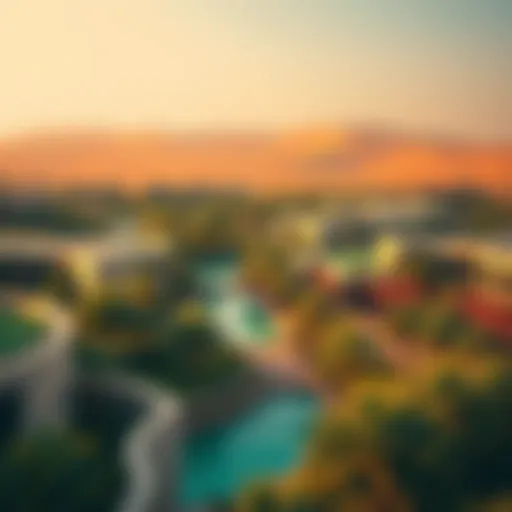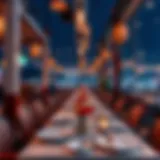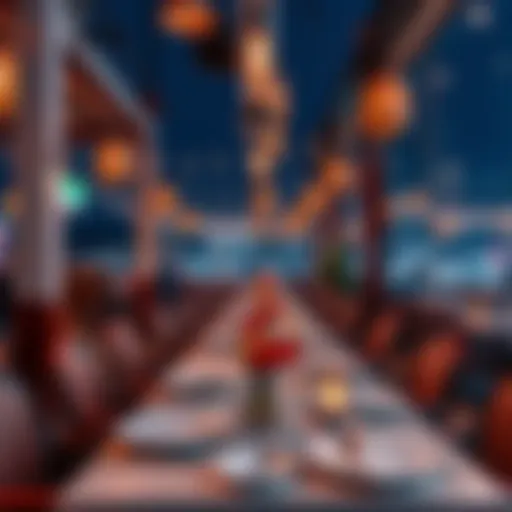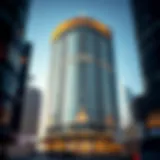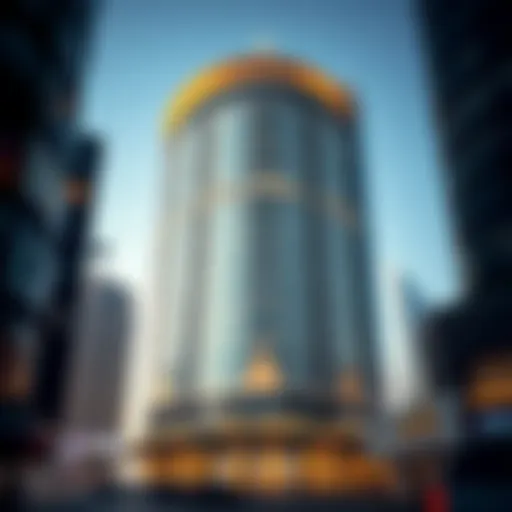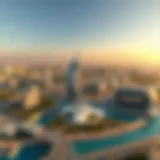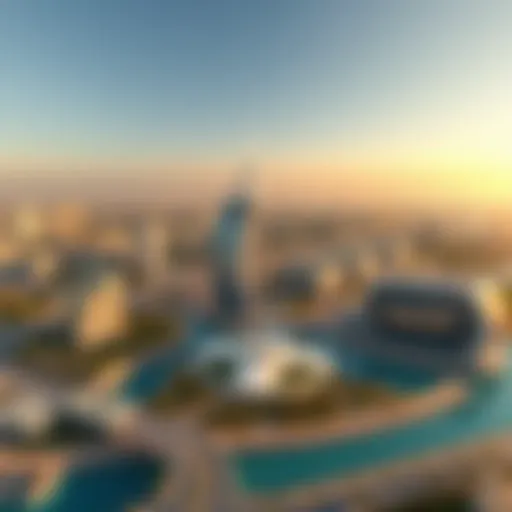Exploring the Rafco Building: A Landmark in Dubai


Intro
Nestled amidst the hustle and bustle of Dubai, the Rafco Building serves not only as a shelter for businesses but as a symbol of the city’s relentless march toward modernization. With its unique blend of traditional influences and contemporary design, this iconic structure is more than just an architectural feat; it's a cornerstone of the local economy and culture. As Dubai transforms at breathtaking speed, the Rafco Building stands resilient, echoing tales of its past while fostering a vibrant future.
In this exploration, we will delve into various facets of the Rafco Building, from its artful architecture to the role it plays in the dynamic tapestry of urban life. Understanding its significance offers insight into not just a building, but an entire ethos that shapes Dubai’s identity.
Let’s begin by setting the stage with a comprehensive overview of the area surrounding the Rafco Building, providing a backdrop that enhances our understanding of its stature within the city.
Preamble to the Rafco Building
The Rafco Building serves as an iconic feature in Dubai’s ever-changing skyline, capturing the essence of this dynamic city, which expertly blends the old with the new. The structure stands not only as a testament to architectural innovation but also represents a vital part of Dubai’s cultural and economic narrative. The importance of the Rafco Building lies in its multifaceted role; it’s more than just a structure of bricks and mortar. It embodies the aspirations and dreams of a rapidly evolving metropolis.
Located in a bustling area, the Rafco Building is a hub of activity, attracting expatriates, tourists, and locals alike. It beckons visitors with its distinctive design and strategic positioning. The introduction of such a landmark contributes significantly to the local economy, providing job opportunities and housing several businesses from various industries. Moreover, its architectural elegance reflects the rich heritage while making a bold statement about the future of Dubai.
Key Elements of the Building
The Rafco Building's importance can be understood through various elements:
- Cultural Symbol: The building showcases how modern design can resonate with local cultural influences. Its architecture often incorporates aspects reminiscent of traditional Islamic patterns and motifs.
- Economic Role: Increasingly, it serves as a venue for business and trade. The presence of multinational corporations within its walls elevates its status as a commercial powerhouse.
- Community Engagement: The building is not just for business; it has also become a space for community events and social interactions, fostering a sense of belonging among residents.
This article aims to explore each facet of the Rafco Building in detail, from its architectural significance and historical context to its impact on the economy and the community. We will delve into how both the past and present coalesce within this structure, ensuring that readers gain a well-rounded understanding of why the Rafco Building stands tall in the heart of Dubai.
"A building is not just a shelter; it is a statement about who we are and what we can achieve."
In the sections that follow, we will unpack the numerous dimensions of the Rafco Building, shedding light on its relevance to both residents and visitors keen to grasp the intricate tapestry of life in Dubai.
Architectural Significance
The architectural significance of the Rafco Building cannot be overstated. It's not just a structure; it embodies the spirit of Dubai's growth and ambition. Just looking at it, you can sense the melding of modern design philosophies with traditional elements, creating a visual narrative that speaks to both residents and visitors. It draws attention as a centerpiece amidst a backdrop of rapid urban expansion, and it serves as a reminder of Dubai's commitment to innovative designs that stand the test of time.
Design Elements
Facade Composition
The facade of the Rafco Building captures the eye with its sleek lines and dynamic surfaces.
Incorporating glass and metal, the composition is not only about aesthetics but also functionality. The reflective surfaces allow sunlight to create a play of light throughout the day, which makes the building shimmer like a gem against the desert sun.
A unique feature here is the layered structure of the facade, which provides shading and reduces heat infiltration—any Dubai resident knows how crucial that can be. This aspect makes it energy-efficient, aligning with modern architectural trends aimed at sustainability.
However, a largely glass facade can bring challenges, like higher maintenance costs and privacy concerns, especially for offices.
Interior Layout
Walking into the Rafco Building reveals an interior layout that promotes interaction and flow. The open-plan spaces allow for flexibility in usage, catering to both small startups and established corporations.
The high ceilings and natural lighting create an inviting atmosphere, fostering creativity and collaboration—essential elements for business success. This design approach reflects a trend in modern architecture where functionality meets aesthetic appeal. But, while open spaces encourage communication, they can sometimes lead to noise and distractions, making it a balance between openness and privacy.
Sustainable Features
Sustainability is woven into the Rafco Building's design ethos. One of its standout aspects is the integrated green technologies used throughout the structure. For instance, water recycling and energy-efficient systems minimize environmental impact.
These sustainable features not only reflect a commitment to ecological responsibility but also offer long-term cost savings for tenants. However, implementing such technologies during construction can be costly and require extensive planning, which is a consideration for future developments.
Comparative Architecture
Contrasting Neighboring Structures
When viewed alongside neighboring buildings, the Rafco Building stands out distinctly. While many nearby structures opt for traditional shapes and materials, Rafco's modern design represents a new era of architectural boldness in Dubai.
This contrast highlights a city in transition. The blending of the old with the new encourages discussions about urban identity, presenting the Rafco Building as a beacon of innovation and change. Yet, this juxtaposition may spark debates among locals regarding architectural heritage and cultural sentiment—nothing like a good discussion over a cup of coffee!
Influence of Islamic Culture
The roots of Islamic architecture influence can be found subtly in the Rafco Building’s complex geometries and ornamental details. This incorporation signifies respect for cultural heritage while embracing contemporary aesthetics.
Aspects like the intricate filigree patterns on certain sections of the facade bring a slice of tradition into the modern context. This effort to respect cultural origins is a plus, as it allows international residents to connect with the local history. However, it’s essential to strike a balance to ensure that progress does not erase the past.
In sum, the architectural significance of the Rafco Building captures the essence of Dubai—a city continually moving forward but never forgetting its origins. This narrative of progress and respect resonates deeply with everyone who interacts with this landmark.
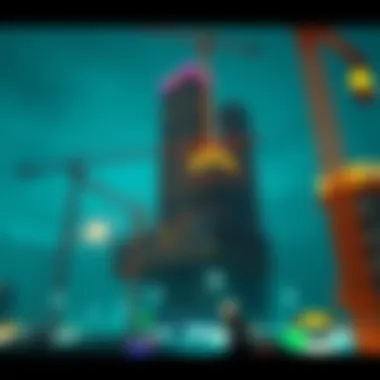

Historical Context
Understanding the historical context of the Rafco Building is crucial not only to appreciate its architectural brilliance but also to grasp its evolving role in Dubai's socio-economic tapestry. The building’s history reflects the rapid growth and transformation of this vibrant city, embodying the aspirations and challenges faced during its development. From initial conceptions to modern-day adaptations, the narrative intertwines Dubai's architectural evolution and cultural shifting, offering insights into why this landmark holds its significant place today.
Construction Timeline
Initial Plans
The initial plans for the Rafco Building were drawn up in response to Dubai's booming economy in the early 2000s. This period saw an influx of investment and tourism, and a pressing need for office space to accommodate businesses sprouting like weeds in springtime.
One standout characteristic of the initial design was its innovative fusion of modernity and traditional elements. Architects aimed to create a structure that wasn't simply athletic in its design, but also expressed the rich heritage of the region. This balance struck by incorporating Arabic motifs and modern building techniques showcased Dubai's ambition and necessity. The unique feature here was the emphasis on functionality without compromising aesthetics, setting a trend for future constructions. Such a thoughtful approach proved beneficial, aligning well with Dubai's narrative of growth and sophistication.
Construction Challenges
Building the Rafco presented its own set of hurdles. The construction challenges included navigating the fluctuating economy and weather extremes. Workers faced scorching heat that would push most to seek shade, making the working conditions particularly demanding. Moreover, materials shortages further delayed timelines and forced adaptations in strategies, requiring quick thinking and planning.
One remarkable aspect of these challenges was how they prompted the team to innovate, leaning heavily on local resources when feasible. Such a resilience became a hallmark of this project, ensuring that the final version of the Rafco Building will forever tell the story of determination amid adversity, echoing the spirit of Dubai itself.
Official Opening
The official opening of the Rafco Building in 2008 marked a new era for the company and the city. It was not just about unveiling a structure; it symbolized Dubai's relentless pursuit of becoming a global hub for commerce. The event garnered attention, showcasing everything from speeches of dignitaries to cultural performances that brought the community together.
Notably, this opening featured a key characteristic: a collaborative effort that bridged business and culture, a rare feat that would inspire future developments in Dubai. This momentous event laid the groundwork for the building's presence in the corporate world while endorsing its role as a social hub, ticking both boxes of economic and community engagement.
Evolution through the Years
Major Renovations
Through the years, the Rafco Building underwent major renovations in response to the evolving needs of its tenants and the city around it. These renovations were not mere touch-ups; rather, they represented a deep commitment to sustainable development. For instance, blending modern technologies into the existing infrastructure enhanced energy efficiency, capturing the attention of eco-conscious businesses.
Such renovations speak to the overarching theme of adaptability in architecture, making the building more relevant in today’s market while preserving its historical essence. This alignment between modernization and heritage has allowed Rafco to remain a heavyweight in real estate, proving to be a wise and forward-thinking choice.
Cultural Events Hosted
The Rafco Building has served as a stage for numerous cultural events since its inception, acting as a vibrant community hub. Hosting art exhibitions, food festivals, and local cultural showcases reflects its role beyond just being an office space.
A compelling feature of these events is how they foster local engagement and attract expatriates and tourists alike. The variety of events organized has strengthened community bonds, making the Rafco Building not just a place to work but a communal cornerstone in the city. Such engagements highlight the building's multi-dimensional value to Dubai, well-integrated into the pulse of the city's cultural life.
Economic Impact
The Rafco Building stands as a pivotal component in Dubai’s rapidly evolving urban landscape. Its influence on the economy is multi-faceted, encompassing various dimensions from business tenancy to job creation. Understanding the economic impact of this landmark is vital for grasping its significance in both local and larger contexts. As businesses flourish within its halls, the building drives industry growth and attracts investments—significantly enhancing the local economic fabric.
Business Tenancy
Major Tenants
One of the defining features of the Rafco Building is the diverse range of major tenants that occupy its spaces. Companies of varying sizes, from startups to well-established firms, rent offices here, creating a vibrant business environment. This variety not only adds to the building's appeal but also helps in creating a cross-industry synergy. The presence of international firms here could signal to potential investors that this area is receptive to global business operations.
Additionally, major tenants value the location in the Rafco Building for its accessibility and modern amenities. These elements come together, making it a favorable choice—in fact, a sought-after one—for companies aiming to establish themselves in Dubai.
Industry Growth
The impact of the Rafco Building on industry growth cannot be overstated. The combination of tech firms, financial institutions, and service providers creates a dynamic ecosystem. This building has become synonymous with innovation and development, attracting companies from nascent to established phases. The result is a thriving marketplace that not only enhances competition but also encourages collaboration among tenants.
Such industry growth influences the entire region, making it a hotspot for economic activity and driving forward Dubai’s reputation as a business hub. However, this growth isn't without challenges; ensuring that the infrastructure can support the rapid expansion is crucial for sustainable development.
Contribution to Local Economy
Job Creation
Job creation is a significant outcome of the Rafco Building's economic impact. The building houses a myriad of businesses that generate employment opportunities for both locals and expatriates. From administrative roles to specialized positions, the jobs created here can greatly boost the local labor market.
Furthermore, the building's job creation potential plays a role in attracting a skilled workforce to Dubai. Skilled workers from various fields are drawn to the opportunities aggregated in this landmark, contributing to the overall dynamism of the local economy. This can lead to an upward trajectory in living standards for community members as well.
Investment Attraction
The Rafco Building has been instrumental in attracting investment to the area, bolstering the local economy profoundly. Investors are often drawn in by the building’s mix of established tenants and new startups, which showcase the robust business environment.
An essential characteristic of investment attraction related to this building is its location within Dubai—a city known for its hosting of major global events and an environment conducive to international trade. This not only solidifies the building's role as a magnet for capital but also ensures that community development progresses alongside. However, fluctuating market trends need to be monitored to avoid saturation, which can deter potential investors from looking into this area.
Community Role
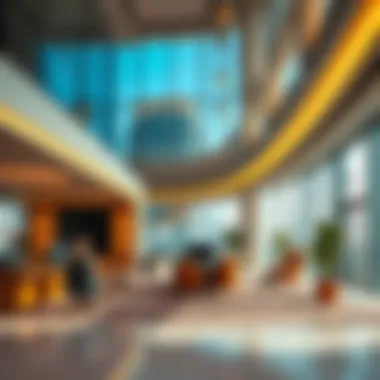

The Rafco Building plays a vital role in shaping the community dynamics around it. Beyond being just an architectural marvel, it creates a vibrant space for interaction and a hub for social engagement. This integration into the fabric of Dubai holds significance, contributing to both the social and civic life within the city. Many residents and visitors find it more than just a structure; it’s a gathering spot that fosters a sense of belonging and community spirit.
Gathering Space
Public Areas
The public areas within the Rafco Building serve as an essential feature that enhances not only accessibility but also user experience. These spaces are designed with open designs that draw in natural light, making them inviting for people to come together. The key characteristic here is the ample seating and landscape design that encourages relaxation and social interaction, offering an accessible oasis amidst the bustling urban environment.
A standout unique feature of these public areas is their multifunctionality. They can host spontaneous meet-ups or casual conversations while offering a quiet spot for solitary reflection. This adaptability advantage promotes community interaction while still catering to individual needs. However, a potential disadvantage might be the challenge of overcrowding during peak times, which can limit the comfort and usability of these spaces.
Event Hosting
Event hosting capabilities within the Rafco Building also make it a prime venue for various community activities. The wide-open spaces can accommodate cultural exhibitions, corporate events, and even communal celebrations. This feature is particularly beneficial as it aligns with the building’s role as a cultural landmark, bringing different cultural narratives to the forefront.
A unique aspect of event hosting is its diversity; it isn’t just limited to formal gatherings. This space can also cater to informal get-togethers, such as art shows or food festivals, which resonate greatly with the local populace. The advantage is clear: it cultivates community spirit and unity among diverse populations. On the flip side, arranging events requires meticulous coordination with local authorities, which can sometimes become a logistical hurdle, especially given the building's busy schedule.
Civic Engagement
Local Partnerships
Local partnerships formed around the Rafco Building can significantly enhance community engagement. These collaborations with both private sectors and non-profit organizations provide opportunities for pooling resources to tackle local issues. The key characteristic of such partnerships is their ability to unite different sectors towards common goals, such as sustainability initiatives or cultural programs.
This unique linkage creates a rich tapestry of shared responsibilities and benefits that can uplift the entire community. They not only provide financial support but also foster a sense of shared mission among diverse groups, boosting overall civic pride. However, one disadvantage can be the uneven power dynamics that sometimes emerge, where larger partners might overshadow smaller ones.
Support for Community Initiatives
Support for community initiatives is another critical aspect of the Rafco Building’s role. This support manifests in various forms, including spaces designated for local artisans, supporting charity events, or hosting workshops for students and young professionals. These efforts mark an essential contribution to the overall growth of the community, particularly in nurturing local talent.
A significant advantage appears with the visibility this brings to local initiatives, fostering a culture of innovation and community-driven projects. On the downside, if not executed properly or if fundraising efforts do not meet goals, they might collapse, leaving a gap in services that had come to be expected by the community.
"The Rafco Building’s contribution transcends bricks and mortar, shaping social landscapes and community spirits in downtown Dubai."
In summary, the community role that the Rafco Building plays is multifaceted and underscored by its gathering spaces and engagement initiatives. These features not only redefine how residents interact with each other but pave the way for a thriving culture that thrives on communication and partnership.
Cultural Importance
The Rafco Building isn’t just a structure made of steel and glass; it stands as a symbol of Dubai's rich tapestry of culture. As the city continues to evolve, landmarks like Rafco take center stage in tales of tradition meeting modernity. The architectural elegance aside, its cultural significance lies in how it fosters community and creativity, transforming the urban landscape into a living canvas.
Art and Installations
Public Art Displays
Public art displays within and around the Rafco Building serve as visual narratives that breathe life into the structure. One standout aspect is how these installations reflect the local culture and identity, merging aesthetics with storytelling. These art pieces, often created by regional artists, invite onlookers to pause and absorb the cultural essence of Dubai. Including informative plaques aids visitors in understanding the concepts behind the displays, creating a link between art and education.
The key characteristic of these displays is their accessibility. Unlike private art shows, public installations invite everyone, from tourists to locals, to engage with art in an open space. A unique feature of the public art display at Rafco is its rotation—new artists are frequently featured, giving fresh perspectives and enhancing community involvement. This aspect not only promotes local talent but fosters a sense of pride among residents.
However, there are drawbacks. Weather can affect the condition of outdoor installations, and some pieces might not resonate with every visitor's taste. Yet, the overall contribution to the fabric of the urban environment is significant, making it a beneficial choice for highlighting culture.
Artist Collaborations
Collaborations with artists are another pillar supporting the cultural importance of Rafco. These partnerships result in unique creative endeavors, enhancing the building’s allure and inviting dialogue around contemporary issues. For instance, artists are often inspired to create pieces addressing environmental sustainability, weaving important messages into their works.
The key characteristic of these collaborations is their fluid nature. Artists from various backgrounds contribute their styles and narratives, reflecting the diversity of Dubai itself. A unique feature could be a collaborative mural project that evolves over time, showcasing how art can represent change. Such projects can bring together communities, fostering conversations and relationships among diverse groups.
Despite their advantages, collaborations can lead to conflicts in vision or execution. Miscommunication can sometimes result in works that don't align with the Rafco's ethos, although careful curation can mitigate this risk. When successful, these collaborations elevate not only the building but the cultural narrative woven into the city's fabric.
Cultural Events
Festivals Celebrated
Within the Rafco Building’s walls and surrounding spaces, festivals celebrated serve as windows to the local customs and traditions. These events, which can range from food festivals to art fairs, highlight the dynamic spirit of Dubai and its embrace of multiculturalism. This specific facet of cultural importance cultivates a sense of belonging and identity, offering residents and tourists alike an opportunity to partake in communal celebrations.
The key characteristic of these festivals is their inclusiveness. They often feature a range of activities that cater to various interests, fostering interaction among diverse demographic groups. Unique to Rafco is its ability to transform ordinary spaces into vibrant festival grounds, encouraging spontaneous gatherings, live performances, and workshops. This engenders community engagement, as people come together to celebrate diversity.
On the downside, large crowds can at times overwhelm local businesses and amenities, leading to logistical challenges. Nonetheless, such festivals remain a cornerstone of Rafco’s cultural contributions, adding vibrancy to the urban landscape.
Cultural Exhibitions
Cultural exhibitions add another layer of depth to the Rafco Building's narrative. These curated showcases offer insights into the rich heritage of the region and beyond, revealing artistic expressions and historical contexts that otherwise might go unnoticed. These exhibitions play a crucial role in educating both locals and visitors about the cultural significance of the area.
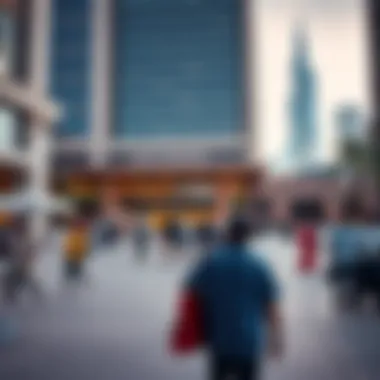

A notable characteristic of these exhibitions is their thematic variety. From contemporary art to showcases on traditional crafts, each exhibition presents a unique opportunity for learning and reflection. A unique feature of the exhibitions at Rafco is the ability to feature both international and local artists, thus creating a dialogue between global art trends and regional themes. This cross-pollination encourages innovative expressions and broadens the audience’s understanding.
However, exhibitions require substantial planning and resources to execute effectively. If not managed well, they may fail to attract the expected audience, leading to a missed opportunity for cultural exchange. Yet, they remain a vital component of Rafco's identity, forging connections and enriching the community’s collective memory.
Future Prospects
In considering the Rafco Building's future in the ever-bustling context of Dubai, several aspects come into focus. The next chapter for this architectural gem is packed with potential, looking toward innovations that can enhance its role in the community, bolster its economic impact, and solidify its status as a landmark that embodies both history and modernity.
Planned Developments
Renovation Plans
The renovation plans for the Rafco Building aim to breathe new life into its spaces while maintaining its original architectural charm. The key characteristic of these plans is the embrace of modern design elements combined with sustainability. Renovations often include updating the interiors with energy-efficient systems and integrating more green spaces. Such changes not only enhance the aesthetic appeal but also align with current trends focusing on eco-friendliness.
A unique feature of these renovation plans is the incorporation of smart technology in everyday operations. With building management systems increasingly driven by AI, the Rafco Building can optimize its energy usage effectively. The advantages here are significant: improved comfort for tenants, reduced operational costs, and a strong message of sustainability that attracts environmentally conscious businesses.
Expansion Proposals
Expansion proposals are another aspect of the Rafco Building's future that holds considerable promise. These endeavors often aim to add to the existing footprint of the structure, making room for new tenants and amenities. A prominent characteristic of these proposals is the focus on multifunctional spaces that cater to both office and recreational needs. This trend reflects a broader move towards creating more integrated environments in urban settings.
One of the unique features of proposed expansions is the potential addition of outdoor areas such as cafes and parks that blend with the surrounding urban landscape. These attributes can greatly enhance community interaction and improve the overall appeal of the location. Yet, expansion comes with challenges, including navigating zoning laws and the potential temporary disruption during construction phases, which may affect current tenants.
Potential Challenges
Market Trends
When it comes to market trends, the Rafco Building finds itself at a crossroads. The commercial real estate market in Dubai is ever-evolving, influenced by factors such as fluctuating demand and economic cycles. The notable characteristic of current trends is the shift towards remote working models, which raises questions about space utility in office buildings like Rafco. Despite these challenges, adaptation can lead to innovation; flexible workspaces and co-working environments may emerge as the solution, enticing a broader range of tenants.
An essential aspect of this dynamic is the ability of the Rafco Building to pivot in response to these trends. However, failure to adapt promptly may hinder its attractiveness to potential businesses, raising the specter of higher vacancy rates.
Environmental Considerations
Environmental considerations are increasingly at the forefront of discussions about the future of any building, and the Rafco Building is no exception. A focus on environmental responsibility is not just beneficial; it is becoming a necessity in today's climate-aware society. One key characteristic of this focus is the integration of sustainable practices into building operations, which can include everything from waste reduction programs to water conservation systems.
Proposals for enhancing sustainability features may also include solar panels or rainwater harvesting systems, which can greatly reduce long-term costs while promoting a greener image. However, one potential challenge of implementing these systems lies in the initial investment costs, which can be substantial and may deter immediate adoption. The continued pressure to meet environmental standards means that addressing these considerations within the Rafco Building's future development plans is not simply wise but essential.
The Rafco Building's future holds a wealth of opportunities, provided it meets evolving market demands and environmental standards, ensuring its place in Dubai's vibrant landscape.
Visitor Information
Visiting the Rafco Building provides an opportunity to appreciate not just the structure itself, but also its surroundings and what it signifies within Dubai. Engaging with this landmark enriches one’s experience in the city, whether you are a local, a tourist, or an expat. Knowledge of visitor information is key to making the most out of your trip.
Access and Transportation
Public Transport Options
Public transport in Dubai is famed for its efficiency and reach. You can catch the Metro, which has stations that are quite near to the Rafco Building. The Dubai Metro boasts an extensive network that connects various parts of the city seamlessly. The nearest stations are just a stone's throw away, making it super convenient. Besides the Metro, buses and taxis are always at your disposal, providing flexible options to tailor your journey. With affordable fares, public transport isn’t just easy on the wallet, but also good for the environment considering the city’s eco-friendly objectives. A unique feature is the ease of transferring between different modes of transport with single payment options available. However, it can get crowded during peak hours, which is something to keep in mind.
Parking Facilities
For those using their own vehicles, the Rafco Building offers ample parking facilities. With multiple levels of parking available, you can expect a hassle-free experience finding a spot. Notably, these facilities are often monitored, ensuring higher security. Easy access to the building means you won’t be trekking for miles to get inside, making it a great choice if you prefer driving. A drawback, however, can be the parking fees associated with busy times, and on weekends, it tends to fill up quickly.
Nearby Attractions
Landmarks
The architecture surrounding the Rafco Building tells a story of its own. Nearby, you can find iconic structures like the Burj Khalifa and Dubai Mall, which are among the most photographed places in the city. These landmarks not only attract tourists but also serve as a point of reference for locals. The charm of these landmarks is enhanced by their proximity to the Rafco Building, allowing visitors to make a day out of exploring. However, with the increasing number of visitors, it’s wise to plan your visits during quieter times.
Dining and Shopping
When hunger strikes after exploring, a plethora of dining and shopping options await just a short walk from the Rafco Building. From high-end eateries to food trucks offering local delicacies, there’s something to satisfy every palate. The shopping experiences range from luxury boutiques to traditional souks, presenting an array of choices that reflect Dubai's cosmopolitan ambiance. A unique feature is the mix of local and international brands, giving a taste of both the traditional and the contemporary. Nevertheless, peak dining hours can result in waits, so it’s prudent to arrive early or make reservations if you have a particular restaurant in mind.
Closure
In wrapping up our exploration of the Rafco Building, it's clear that this structure doesn't just sit quietly in Dubai's skyline—it resonates with the very essence of the city’s evolution. As a landmark, it embodies the fusion of tradition and modernity, standing as a testament to what Dubai has achieved and what it aspires to be in the future.
Understanding its Importance:
The Rafco Building is more than just a physical space; it represents a convergence of architectural elegance and cultural identity. By analyzing its design, historical context, and economic impact, one can truly appreciate how this building enhances the lives of those who occupy and visit it. The way the building adapts to meet both community needs and business demands reflects a broader trend in urban development: a commitment to sustainability and cultural integration.
“A building’s value is not just in its structure, but in the stories it tells and the lives it shapes.”
Benefits of the Rafco Building:
- Cultural Hub: The building serves as a platform for cultural events, providing space for art installations and community gatherings that foster social interaction.
- Economic Contributor: Its role in attracting major tenants bolsters the local economy, creating jobs and driving growth in various sectors.
- Architectural Gem: The thoughtful design elements not only allure the eyes but also set a benchmark for future constructions in Dubai, echoing Islamic influences.
Considerations Going Forward:
As Dubai continues to transform, so too will the Rafco Building's role in its narrative. Stakeholders and city planners must ensure that future developments respect this landmark's historical significance while embracing innovative practices. The juxtaposition of preserving tradition and accommodating modern demands will be crucial in maintaining the building's relevance.
Ultimately, the Rafco Building stands as a pillar of identity, capturing the spirit of its surroundings and the dreams of those who call Dubai home. It invites us all—expats, tourists, and locals alike—to engage with its legacy and envision what lies ahead in this dynamic metropolis. Let the Rafco Building not merely be a backdrop in your travels but a place to understand and connect with the heart of Dubai.

